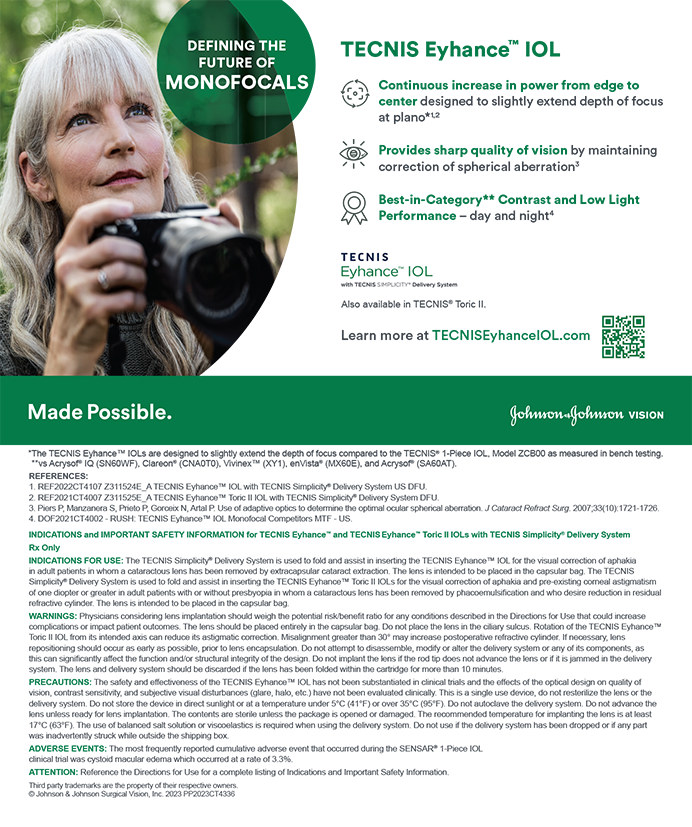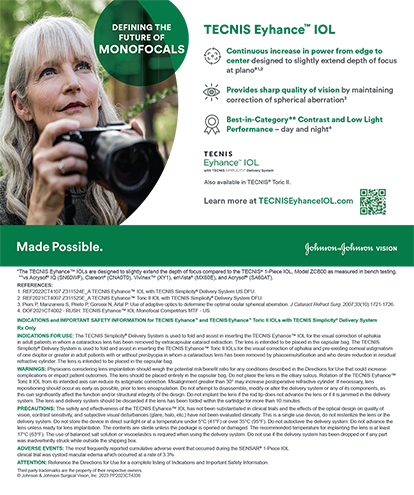MELISSA MORRISON CABLE, MD
This complex clinical problem focuses on an elderlybut motivated patient who desires bilateral distance correctionwithout contact lenses or glasses. Previous bilateralhyperopic LASIK, phacoemulsification, anisometropia,and superficial keratitis complicate the matter.Interpalpebral superficial punctate keratitis can be consistentwith dry eye or nocturnal opening of the eye. Iwould initiate treatment with preservative-free artificialtears, ointments, and possibly Restasis (Allergan, Inc.).Problems with the ocular surface can compromiserefraction, so I would confirm the measurement beforeproceeding to the next step.
The options for correcting the patient’s right eyeinclude an IOL exchange, a LASIK/PRK enhancement, ora piggyback lens. Because the posterior capsule is intactand the silicone plate lens is known to resist adherenceto the posterior capsule, I would recommend an IOL exchangein this case. I would optimize the IOL power calculationwith a postcorneal refractive surgery formula such as the one described by Wang, Hill, and Koch (currentlyunpublished). I would choose a traditional sphericalmonofocal lens with positive spherical aberrations tooffset the negative corneal aberrations from previousLASIK. Zero-aberration lenses are another option toreduce confounding aberrations. An Nd:YAG capsulotomycould be performed in the future to further enhancevisual acuity.
Based on the case presentation, cataract surgery is notindicated for the patient’s left eye. Once the vision in herright eye stabilized, if the patient desired additional correction,I would propose a keratorefractive enhancement,specifically PRK over the LASIK flap to reduce therisk of epithelial ingrowth. Mitomycin C should be usedto minimize corneal haze.
KENNETH J. ROSENTHAL, MD
The first step is to determine what the patient wants.If she really desires freedom from spectacles at distanceand hates wearing glasses, then she is an ideal candidatefor multifocal vision rather than myopic correction. Sheclaims she does not want to wear glasses at distance, butdoes she fully understand that a surgical solution willeliminate her uncorrected near vision?
If she chooses to proceed, I would offer to perform arefractive lens exchange with a multifocal IOL in the fellow,previously unoperated eye. This traditional, straightforwardsurgical procedure would afford the patient thegreatest degree of true spectacle independence with theleast risk. After reassessment, if she were still unhappywith her vision due to residual myopia in her right eye,the options would be sequential LASIK (or surface ablation)to correct the myopia, a piggyback IOL, or an IOLexchange for a multifocal IOL.
In this scenario, I would favor an IOL exchange withimplantation of a multifocal IOL, both because of findingsconsistent with ocular surface disease (which surfaceablation could exacerbate) and to provide theopportunity for presbyopic correction. The ocular surfacedisease should be addressed concomitantly with thesurgical preparation, because failure to do so mightresult in increased higher-order aberrations and less satisfactoryvisual results. I use corneal topographic wavefrontaberrometry to guide my choice of IOL, and itwould be key to the lens’ selection in this case. Becauseof the previous hyperopic LASIK, the patient is likely tohave low or negative spherical aberration, in which casean IOL without a prolate optic would be preferable.When the procedure is performed this long postoperatively,I can usually achieve a careful hydro/viscodissectionand viscoelevation.
Although plate haptics can usually be manipulated out of the bag with relative ease, I would amputate andleave the plate haptic behind if it were too adherent tothe capsule. After polishing the metaplastic lens epithelialcells from the posterior capsule, I would place themultifocal IOL in the capsular bag if the capsular forniceswere expandable and could accommodate thelens. Otherwise, I would capture the optic within thecapsulorhexis and place the haptics in the sulcus.Sometimes, a capsular tension ring can be inserted, orthe haptics can be sutured to the posterior iris to furtherstabilize and ensure centration of the IOL. Additionally,my unpublished data demonstrate the effectiveness ofcapsular tension rings for both stability and theenhancement of accommodation among patients whoreceive the Crystalens (Bausch + Lomb, Rochester, NY),even when the IOL is secondarily implanted.
My second choice for surgery in this case would be apiggyback IOL, either a sulcus-fixated lens or a PCIOLplaced in the anterior chamber. With the latter, I wouldsecure the haptics to the anterior surface of the iris witha modified McCannel suture.1 Compared with sulcusfixation, this approach will reduce the chance of intralenticularopacification when like materials are used—inthis case, a silicone IOL such as the AQ5010 (STAARSurgical Company), which is available in low minuspowers.
In hindsight, the refractive surprise in this case couldhave been expeditiously resolved by an IOL exchangeperformed within days or weeks of the primary cataractsurgical procedure. This solution would have saved botha lot of toil on the part of the current surgeon and agreat deal of unhappiness on the part of the patient.
WILLIAM B. TRATTLER, MD
In this case, the previous hyperopic LASIK treatmentmay have increased the risk for a myopic surprise. Thetwo options that I would consider are laser vision correctionor a piggyback IOL. Both techniques are effective.In my practice, I perform laser vision enhancementsfor the vast majority of cases, so that would be my recommendationto this patient.
The first step is to evaluate the ocular surface and lid margin. In a recent multicenter study, my colleagues and I found that about50% of patients have central corneal staining prior to cataract surgery.2Another study found that lid margin disease was present in more than 50%of patients scheduled for cataract surgery.3 This patient’s dry eye diseaseand/or blepharitis needs to be identified and treated.
Once the ocular surface was healthy, I would perform corneal topographyto confirm that the hyperopic ablation is well centered. If so, the patientwould be a candidate for a refractive enhancement with laser vision correction.First, I would perform an Nd:YAG capsulotomy, because the refractiveerror might change afterward. I would re-evaluate the patient 1 month afterthe capsulotomy to finalize the preoperative measurements for laser visioncorrection. In a case of previous LASIK, I prefer to perform a surface enhancement.Other surgeons may lift the flap or use the IntraLase (Abbott MedicalOptics Inc., Santa Ana, CA) to create a new side cut for lifting the flap.
For surface ablation over previous LASIK, I highly recommend the use ofdilute alcohol to loosen the epithelium, which I slide away from the LASIKflap’s hinge. After the ablation, I apply mitomycin C 0.02% to the stromalbed for 12 to 20 seconds, followed by the placement of an Acuvue Oasysbandage contact lens (Johnson & Johnson Vision Care, Inc., Jacksonville, FL).I would expect the refractive enhancement to effectively reduce the patient’smyopic error and increase her uncorrected distance vision to a satisfactorylevel.
Section editor Bonnie A. Henderson, MD, is a partner in OphthalmicConsultants of Boston and an assistant clinical professor at Harvard MedicalSchool. Tal Raviv, MD, is an attending cornea and refractive surgeon at the NewYork Eye and Ear Infirmary and an assistant professor of ophthalmology at NewYork Medical College in Valhalla. Dr. Henderson may be reached at (781) 487-2200, ext. 3321; bahenderson@eyeboston.com.
Melissa Morrison Cable, MD, is a partner at Discover VisionCenters in Independence, Missouri. She acknowledged no financialinterest in the product or company she mentioned. Dr. Cable maybe reached at (816) 478-1230; mcable@discovervision.com.
Kenneth J. Rosenthal, MD, is the surgeon director at Rosenthal EyeSurgery. Dr. Rosenthal is also an attending cataract and refractivesurgeon at the New York Eye and Ear Infirmary and an associateprofessor of ophthalmology at the John A. Moran Eye Center,University of Utah School of Medicine, Salt Lake City. He is a consultantto, has received honoraria from, and is on the speakers’ bureau of AbbottMedical Optics Inc., and he has received honoraria and travel reimbursementfrom Bausch + Lomb. Dr. Rosenthal may be reached at (516) 466-8989;kenrosenthal@eyesurgery.org.
William B. Trattler, MD, is the director of cornea at the Center forExcellence in Eye Care in Miami. He is a consultant to AbbottMedical Optics Inc. and has received research support from VistakonPharmaceuticals, LLC. Dr. Trattler may be reached at (305) 598-2020; wtrattler@earthlink.net.
- Baker Schena L.Anteriorly sutured PCIOLs may overcome weak capsular support.EyeNet Magazine.Published January 2009.http://www.aao.org/publications/eyenet/200901/cataract.cfm.Accessed April 20,2010.
- Trattler W,Goldberg D,Reilly C.Incidence of concomitant cataract and dry eye:prospective health assessment of cataract patients.Presented at the WorldCornea Congress;April 8,2010;Boston,MA.
- Luchs J,Buznego C,Trattler W.Prevalence of blepharitis in patients scheduled for routine cataract surgery.Presented at:The ASCRS Symposium onCataract,IOL and Refractive Surgery;April12,2010;Boston,MA.


